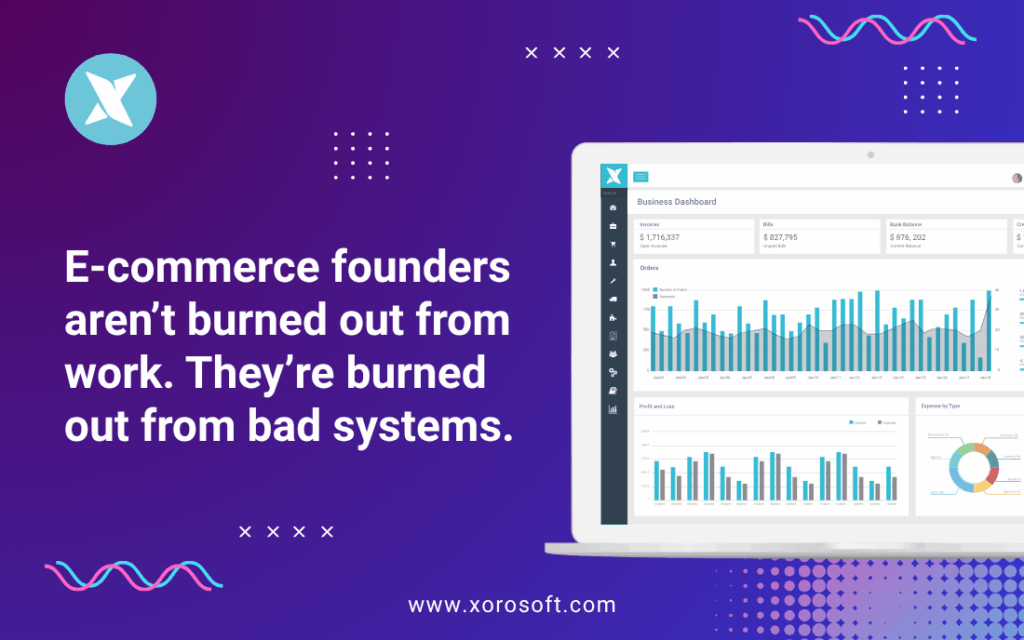
Why Operational Stress Hits Founders So Hard
Running an e-commerce brand should feel energizing and creative. Yet many founders burn out because their operations rely on disconnected tools and slow manual processes. This is why adopting an operations management system becomes essential from the very beginning. Because these systems remove friction and create clarity, they allow founders to focus on growth instead of constant firefighting. Consequently, teams gain the freedom to operate with less stress and more confidence.
When systems don’t talk to each other, every decision takes longer than it should. Furthermore, leaders spend valuable time chasing information that should be instantly available. As a result, the business slowly loses momentum. With a modern operations management system, however, clarity returns quickly and operations begin to stabilize.
Why Founders Need a Modern Operations Management System
Most brand leaders want to spend their time designing better products, improving customer experience, and driving growth. However, they often get pulled into operational problems that drain their attention.
Because multiple systems store conflicting data, simple questions take too long to answer. Inventory might display one number on Shopify, another on Amazon, and a different value inside a spreadsheet. Meanwhile, warehouse teams might be picking orders based on outdated or mismatched information. As a result, planning becomes reactive instead of strategic.
With a centralized operations management system, these issues dissolve. Data updates instantly, teams operate with clarity, and decisions become faster. In addition, the organization gains the stability required to scale without adding unnecessary complexity.
Operational Challenges That Disrupt Brand Growth
Although operations vary across brands, most fast-growing companies encounter similar friction points. These issues remain invisible for too long, and they gradually slow down the entire business.
Fragmentation Creates More Work
Many brands begin with small, standalone tools. Although this works early on, it becomes complicated as order volume grows. Systems operate independently, which means each team must manually bridge the gaps. Consequently, problems compound as the business scales.
Outdated Inventory Data Limits Planning
When tools do not sync in real time, inventory numbers become unreliable. Therefore, planners rely on estimates instead of accurate projections. This leads to overselling, stockouts, and costly purchasing decisions.
Manual Warehouse Tasks Increase Errors
Without standardized warehouse workflows, teams rely on judgment calls instead of consistent procedures. This results in missed scans, wrong picks, and slower fulfillment cycles. As a result, the customer experience suffers, even if the products themselves are great.
Financial Processes Take Too Long
Sales channels, returns, fees, and adjustments exist in different systems. Because of that, finance teams spend days reconciling data each month. Meanwhile, leadership operates with incomplete information.
Leaders Operate Without Real-Time Insight
Teams perform well when they can make fast decisions. However, fragmented tools delay visibility. An operations management system solves this by giving leaders immediate insight into actual performance.
Metrics That Reveal the Strength of an Operations Management System
Although companies track many numbers, only a few truly indicate whether operations are functioning well:
-
Order cycle time: measures how quickly customers receive orders.
-
Pick accuracy: shows execution quality in the warehouse.
-
Inventory turns: reveals how efficiently stock moves.
-
Stockout frequency: indicates planning consistency.
-
Contribution margin: captures the real cost of operational inefficiencies.
-
Cash conversion cycle: measures how long capital stays tied up.
Because the right operations management system displays these metrics in real time, operators can respond before small issues become expensive problems. For example, a sudden dip in inventory turns becomes visible immediately rather than weeks later.
A Practical Framework for Improving Your Operations Management System
Scaling successfully requires a clear approach. Therefore, the following steps outline how brands can strengthen their internal operations in a structured, measurable way.
Create a Single Operational Source of Truth
Operations depend on accurate data. When systems connect through one centralized platform, delays disappear. Teams make decisions based on reliable, real-time numbers.
Goal: unify data
Action: consolidate tools into an operations management system
Metric: system data latency
Achieve Complete Inventory Visibility
Real-time visibility increases confidence and reduces errors. As a result, planners make smarter decisions based on accurate, up-to-date information.
Goal: stabilize inventory
Action: track items in real time across channels and locations
Metric: stockout frequency
Improve Warehouse Efficiency Through Standardization
Warehouse teams work best with defined processes. Barcode scanning, guided picking, and quality checks reduce mistakes and improve order speed. In addition, clear workflows help onboard new team members quickly.
Goal: reduce errors
Action: implement WMS workflows within your operations management system
Metric: pick accuracy
Automate Purchasing and Replenishment
Demand planning becomes more accurate when driven by data. Automated replenishment rules prevent stockouts and overstock problems.
Goal: optimize purchasing
Action: create reorder points and vendor rules
Metric: inventory turns
Strengthen Fulfillment Processes
Better fulfillment tools reduce manual work and eliminate bottlenecks. Therefore, automated routing and batch picking accelerate delivery times.
Goal: speed up fulfillment
Action: automate routing and shipping workflows
Metric: order cycle time
Modernize Accounting and Financial Processes
Integrating accounting with operations ensures accurate landed costs, cleaner reports, and faster month-end closing. As a result, finance becomes proactive rather than reactive.
Goal: improve financial clarity
Action: sync accounting and automate reconciliation
Metric: reconciliation time
Build Live Dashboards for Instant Insight
Dashboards allow leaders to see trends quickly. Furthermore, they improve alignment across operations and finance.
Goal: improve visibility
Action: track KPIs in real time
Metric: contribution margin movement
How One Brand Transformed Its Operations With Better Systems
A fast-growing accessories brand selling through Shopify, Amazon, and wholesale illustrates the impact clearly. Although their team worked hard, they depended on spreadsheets and disconnected tools.
Before Making the Switch
-
Pick error rate reached 17%.
-
Inventory accuracy hovered around 82%.
-
Planners used outdated data, causing frequent delays.
-
Month-end reconciliation took 8–10 days.
-
Teams relied on manual checks for simple stock questions.
After Implementing an Operations Management System
-
Pick accuracy increased to over 99%.
-
Inventory accuracy improved from 94% to 99%.
-
Order cycle time dropped by 33%.
-
Financial reconciliation shrank from 10 days to 2.
-
Team communication improved dramatically.
As a result, leadership gained new confidence in their ability to scale.
A Two-Week Implementation Roadmap for Stronger Operations
Although optimizing operations seems overwhelming, most transformations begin smoothly when following a structured plan.
Map Current Workflows (Days 1–2)
Start by documenting each workflow across inventory, purchasing, warehousing, fulfillment, and finance. Consequently, the weak points become easier to identify.
Identify Bottlenecks (Days 3–4)
Evaluate where delays, errors, or duplicate work occur. For example, repetitive manual checks or inconsistent picking steps highlight high-priority areas.
Consolidate Disconnected Tools (Days 5–6)
Replace overlapping apps with an integrated operations management system. As a result, teams can focus on workflows rather than troubleshooting systems.
Improve Warehouse Execution (Days 7–9)
Introduce real-time inventory tracking, barcode scanning, and guided workflows. Consequently, picking accuracy improves immediately.
Automate Purchasing Logic (Days 10–11)
Set reorder levels and demand-based PO rules. Therefore, purchasing becomes data-driven rather than reactive.
Sync Financial Data (Days 12–13)
Integrate accounting so all transactions, adjustments, and COGS values update automatically.
Launch Weekly KPI Dashboards (Day 14)
Finally, build dashboards to keep leadership aligned. Ultimately, this ensures ongoing visibility.
Common Questions From Operations Leaders
Why is an operations management system essential for scaling?
As brands grow, complexity increases. A unified system prevents the errors and delays caused by disconnected tools.
What makes Xorosoft unique?
Xorosoft is cloud-native, fast to deploy, and includes a built-in WMS. In addition, it integrates with Shopify, Amazon, 3PLs, and popular accounting tools.
How quickly can teams go live?
Most implementations take weeks, not months.
Will teams adopt the system easily?
Yes. Xorosoft is rated #1 in Ease of Use on G2, which increases adoption across all departments.
Where to Go From Here
If your operations feel chaotic, a strong operations management system can restore clarity and consistency. It unifies inventory, purchasing, fulfillment, warehouse execution, and accounting—all in one platform. Because of that, teams work faster and smarter.
To explore the platform further:
When your operations run smoothly, your team performs at its best. And when your team performs well, your brand grows sustainably.









